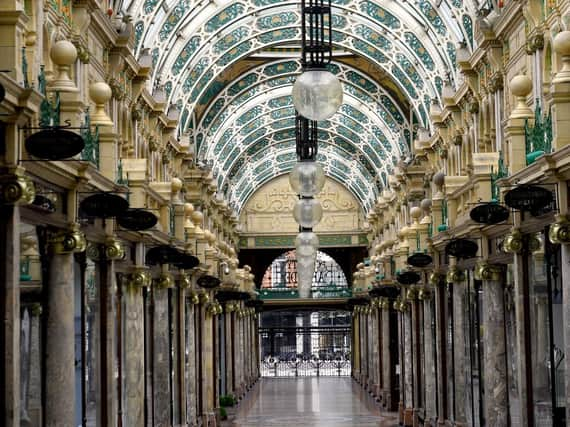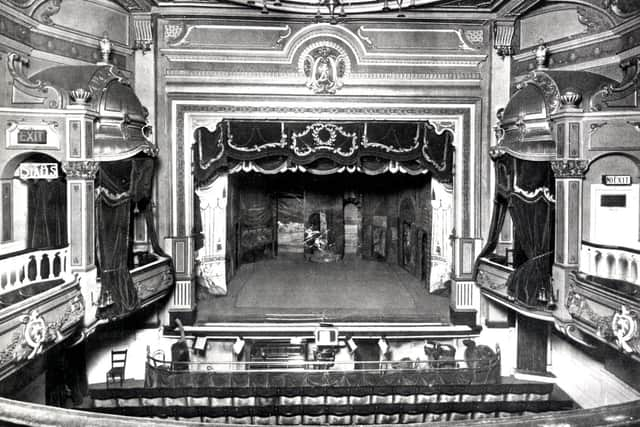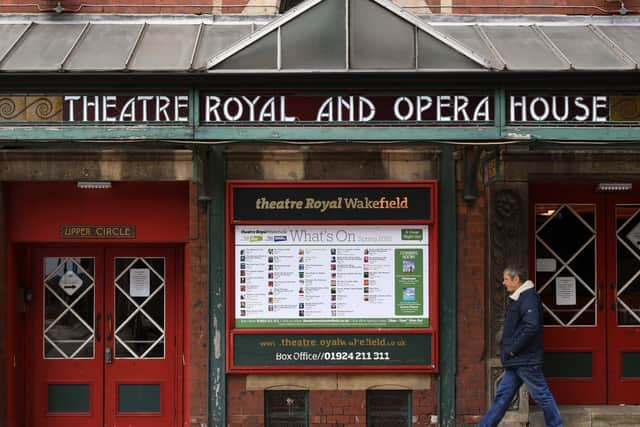This is the legacy of Frank Matcham, the architect behind some of Yorkshire's most recognisable theatres and buildings


Frank Matcham was not only one of the leading architects and designers of the Victorian and Edwardian age, but of any age. A great innovator, many of his buildings can still be found in our towns and cities, including here in Yorkshire. His signature style was one of confident flamboyance, and over the years many millions of people have stepped over the threshold of his palatial designs, especially his theatres.
Matcham was born in Devon, in 1854, and died in Essex in 1920. His legacy is remarkable, but the sad fact is that many of our communities didn’t recognise the beauty and value of a Matcham building, and in the 1950s and 60s several were torn down to make way for shopping developments.
Advertisement
Hide AdAdvertisement
Hide AdHis designs were all different, with flourishes that took the breath away. The facades were splendid and the interiors were eye-wateringly extravagant. A couple from an ordinary home in Shiregreen, in Sheffield, would have been amazed when they took their seats in the city’s opulent Empire Palace on Charles Street. It opened just in time for the Christmas festivities in 1895. Or they could, a few years later, have popped over the road to the Theatre Royal in Tudor Street, where Matcham reorganised and embellished an existing structure.


Sadly, both theatres have disappeared from the landscape – the Empire was demolished in 1959, and the Royal went up in flames just a day before New Year, in December 1935. The fire was so severe the entire roof collapsed and, as it plunged down, it took the gallery, the upper circle and then the dress circle with it. The embers in the sky drifted across to the Lyceum, and that too was in danger for a few hours.
There is a little glimpse into the life of a touring performer at the time – Castelli and his Accordion Band had been to the Royal and left their instruments in the dressing room. They were due to perform the following week but their instruments went up in smoke. However, the kind folk of Sheffield raised £500 so that each of the accordions could be replaced.
Frank Matcham was in demand over on the east coast, too. In 1893, the Hull Grand Theatre and Opera House was built on George Street, at a cost of £20,000. “The finished interior looked far more like a place where you’d expect to find the King of Bavaria sitting in the royal box,” says historian and theatre expert Dr David Wilmore, whose acclaimed Theatresearch archive is based in Dacre, near Harrogate. “Sadly, when the building became a cinema in 1930, this riot of colour was all swept away.”


Advertisement
Hide AdAdvertisement
Hide AdThe Hull (Empire) Palace of Varieties opened its doors on Anlaby Street in December 1897, and the first music played by the pit band was the National Anthem. “The decoration here was in the Moorish style, a complete contrast to the front of the place. It was bomb damaged during the war but they reopened in 1951. It managed to stagger on until the mid-Sixties and was demolished in 1966,” says Wilmore.
Gus Elen, a superstar of his day, was top of the bill on that opening night – which shows that the people of Hull were enjoying great entertainment from first-rate artistes.
Theatre expert John Earl believes that Matcham was a master in his field. “He took his inspiration from everywhere and nowhere, he stood well aside from contemporary architectural fashions. They were totally irrelevant to the kind of magic he was in the business to create.”
It wasn’t just the bigger cities or the larger towns of Yorkshire that got Matcham’s attention – Keighley had its own Queen’s Theatre and Opera House (no less) on Queen Street, which the architect remodelled in 1898 for about £6,000.
Advertisement
Hide AdAdvertisement
Hide AdCastleford, too, had its own Theatre Royal on Albion Road, which could hold 1,000 people when full. It, too, was demolished in the Sixties and a supermarket now stands on the site.
Halifax was blessed with an even bigger venue – the 2,000-seater Grand, on North Bridge, which opened in the summer of 1898. This was a triumph of engineering since it stood on a steep slope. From the Bridge, it was only two storeys high – on the side, it had four.
“The man was, quite simply, a genius,” says Wilmore. “Apart from anything else, you have to remember that this was a huge boom time for the entertainment business, with theatres and then cinemas opening up all over the place.
“Quite apart from the big town and city centres, all the outlying suburbs had at least one picture palace or variety venue, so that on any one night, there must have been many thousands of people paying their hard-earned money at the box office.”
Advertisement
Hide AdAdvertisement
Hide AdMatcham and his clients knew what they were doing. “Nearly every one of his theatres was at the core of a shopping complex. There were some very astute businessmen back then, the shopping mall with its ten-screen cinema complex is no modern concept – Matcham pioneered it.”
A gleaming highlight of this idea is on Briggate, in Leeds. The Victoria Quarter was built around the Leeds Empire Palace and, says Wilmore, “the only bit of visible structure of that beautiful building that remains today is its name, carved into what would have been the lintel of the stage door”.
Happily, the Leeds County Arcade survives and thrives, and it is probably the best example of Matcham’s “complete thinking” that can still be seen. He did the lot – he even designed the uniforms for the waiting staff in the Ceylon Cafe, which was part of the complex. No expense was spared, and when it was nearly all completed in 1900, the Leeds Estate Company had spent £300,000, which was a vast sum at the time.
“I still cannot understand why the then owners decided to flatten the Empire completely in 1962, but then leave just about everything else standing,” says Wilmore. “It’s like having a perfect set of teeth and then asking your dentist to pull one out, so that the smile is ruined. It was an appalling decision, and it robbed Leeds of a masterpiece of architecture.”
Advertisement
Hide AdAdvertisement
Hide AdJust a few miles away in Harrogate is another Matcham gem (Grade II listed) and still very much part of the town’s cultural life. The Royal Hall was originally the Kursaal when it opened in 1903, and changed its name during the Great War. The story here is that the local council of the day wanted an entertainment area and held a competition to find the best design.
There were 14 entries and Matcham was a judge and the “consulting architect”. Nothing appealed to the imagination of the civic powers so Matcham took over and delivered the goods with a rectangular auditorium with a soaring painted ceiling and boxes down either side. It still stops audiences in their tracks to this day. For Yorkshire, it is the architect’s triumph.
The only town in the county which had no less than three Matcham theatres was Wakefield – and thankfully the Theatre Royal and Opera House (another Grade II listing) still presents its impressive face to Westgate. It was where the thriving Matcham Society was founded.
The Wakefield Empire and the Wakefield Hippodrome are long gone. The latter had a short life. It opened in 1909, and closed in 1922, though before it went it was used as a rhubarb shed of all things. “Yorkshire is a wonderful place for anyone who adores Matcham,” says Wilmore. “The terrible sadness is that so many of his marvellous buildings have disappeared – which is why we need to cherish and protect what we have left.”
Advertisement
Hide AdAdvertisement
Hide AdThe Matcham Directory, by Michael Sell. For details go to www.frankmatcham.society.org.uk
Editor’s note: first and foremost - and rarely have I written down these words with more sincerity - I hope this finds you well.
Almost certainly you are here because you value the quality and the integrity of the journalism produced by The Yorkshire Post’s journalists - almost all of which live alongside you in Yorkshire, spending the wages they earn with Yorkshire businesses - who last year took this title to the industry watchdog’s Most Trusted Newspaper in Britain accolade.
And that is why I must make an urgent request of you: as advertising revenue declines, your support becomes evermore crucial to the maintenance of the journalistic standards expected of The Yorkshire Post. If you can, safely, please buy a paper or take up a subscription. We want to continue to make you proud of Yorkshire’s National Newspaper but we are going to need your help.
Advertisement
Hide AdAdvertisement
Hide AdPostal subscription copies can be ordered by calling 0330 4030066 or by emailing [email protected]. Vouchers, to be exchanged at retail sales outlets - our newsagents need you, too - can be subscribed to by contacting subscriptions on 0330 1235950 or by visiting www.localsubsplus.co.uk where you should select The Yorkshire Post from the list of titles available.
If you want to help right now, download our tablet app from the App / Play Stores. Every contribution you make helps to provide this county with the best regional journalism in the country.
Sincerely. Thank you.
James Mitchinson
Editor